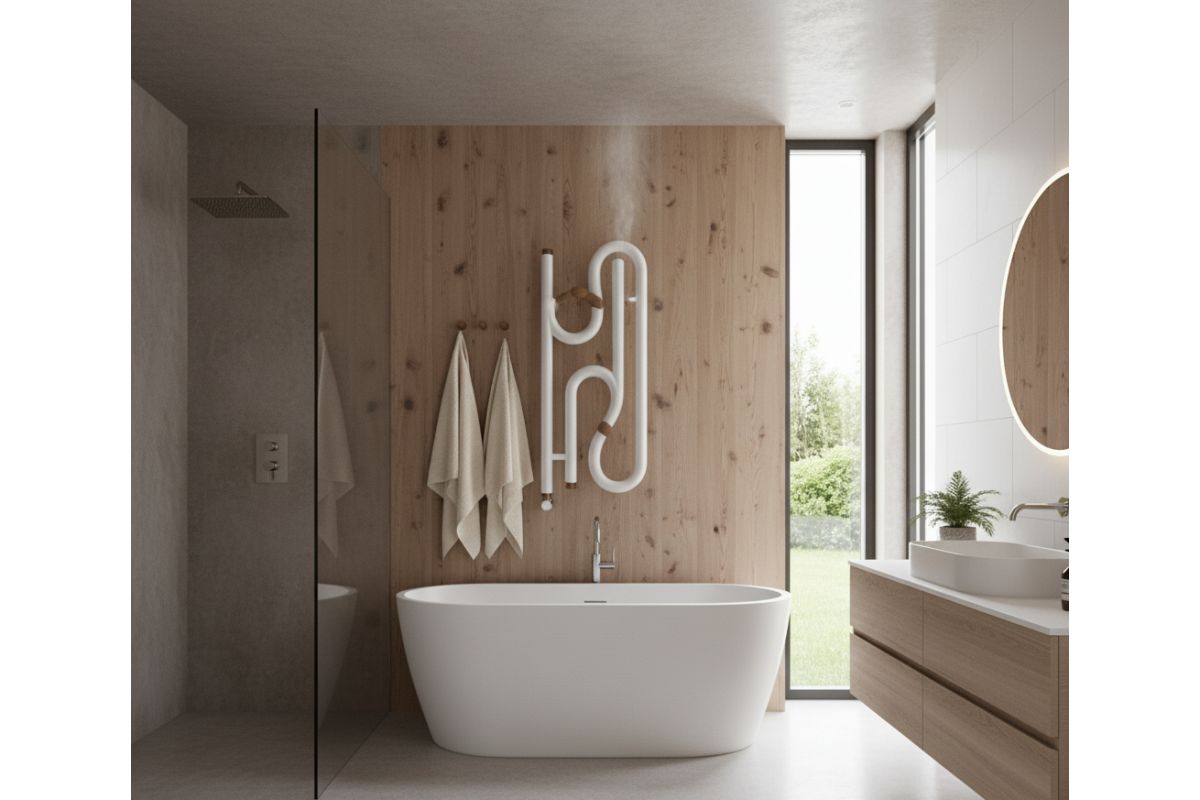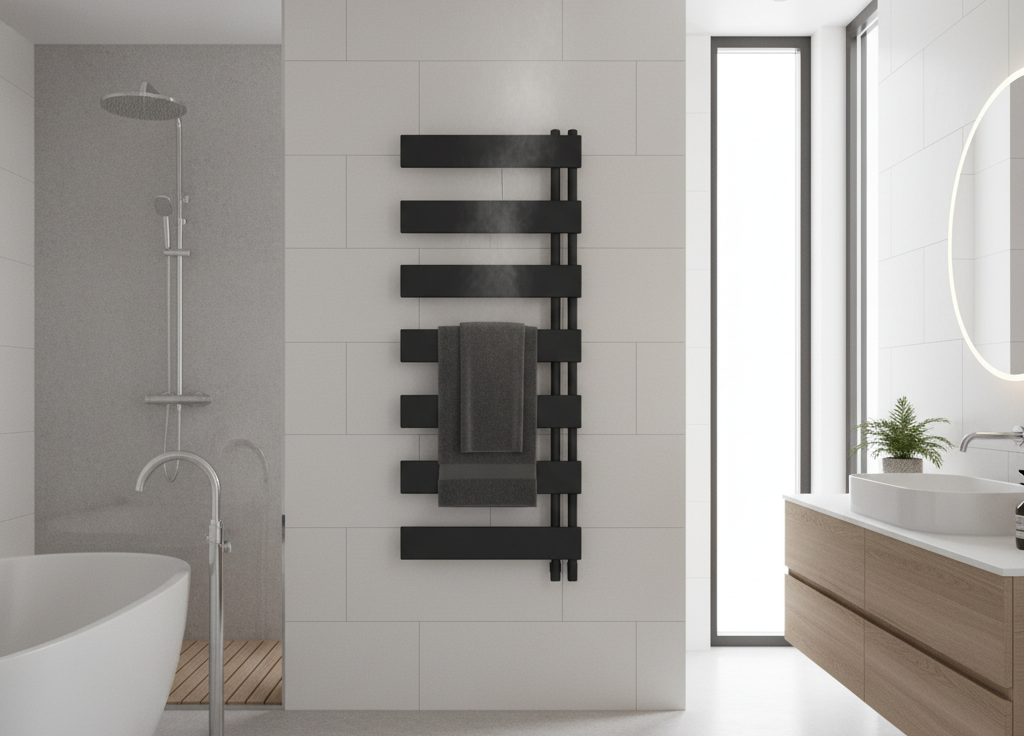Right Size Towel Rail for Your Bathroom

The problem lies in a common misunderstanding of what "size" truly means. Choosing the right towel rail isn't just about finding one that fits neatly on your wall; it's about balancing its physical dimensions with the correct heat output. A common and costly mistake is selecting a stunning rail that is functionally incapable of heating the space, rendering it little more than an expensive towel holder.
This comprehensive guide will demystify the entire process, empowering you with the knowledge to select the perfect Towel Rails Radiators for your bathroom. We will walk you through the key considerations, from technical heat calculations to materials and running costs, ensuring you make a choice that delivers on style, functionality, and value.
Physical Dimensions vs. Heat Output
When selecting a towel rail, the first and most critical concept to grasp is that "size" has two distinct meanings: the physical dimensions of the unit and its heat output. A physically large, tall towel rail can have a surprisingly low heat output, while a more compact model can be incredibly powerful. The professional approach is to determine the heat your room needs first, and only then find a physical model that can deliver it.
Understanding BTU: The Only Metric for Warmth
The non-negotiable starting point for any radiator purchase is its British Thermal Unit (BTU) rating. In simple terms, a BTU is the standard unit of measurement for heat output. The higher a towel rail's BTU rating, the more heat it can produce to warm your room. Every radiator has a specific BTU value, allowing you to compare their heating capabilities accurately.
The Consequences of Getting it Wrong
Choosing a towel rail based on looks alone without first calculating your BTU requirement is a gamble that rarely pays off. An insufficient BTU rating (undersizing) is the most common mistake and will leave your bathroom cold, potentially contributing to damp and mould. While less common, oversizing (too high a BTU) will make the room uncomfortably hot and lead to significant energy waste and high heating bills.
Calculating Your Bathroom's BTU Requirement
To ensure your bathroom reaches a comfortable temperature, your towel rail must have a BTU output powerful enough to compensate for the heat that naturally escapes. While it sounds complex, modern tools have made it a straightforward task.
The Easy Way: Use a BTU Calculator
For the most accurate result, we strongly recommend using a dedicated online BTU calculator. These free tools perform the complex calculations for you, factoring in all the unique variables of your room. To get a precise calculation, you will need to input a few key details about your bathroom:
- Room Dimensions: The length, width, and height of the room.
- Window Information: The size of your windows and whether they are single or double-glazed.
- Wall Information: The number of external walls (walls that face the outside).
- Room Position: What is above and below the bathroom (e.g., another heated room, an unheated loft).
The 'Towel Insulation' Effect: A Common Mistake
A towel rail's stated BTU rating is measured when the rail is completely uncovered. In the real world, its primary purpose is to hold towels, which are excellent insulators. When you drape a thick towel over a heated rail, you trap a significant portion of its heat, preventing it from warming the room.
To counteract this, it is essential to build a buffer into your calculation. As an expert rule of thumb, add a 20-30% surplus to your final calculated BTU requirement. This ensures your towel rail has enough power to both dry your towels and effectively heat your bathroom.
Choosing the Right Physical Dimensions
Once you have your target BTU figure (including the buffer), you can find a towel rail with the right physical dimensions that can deliver that heat output. Many websites allow you to filter towel rails by their BTU output, showing you all the available styles that meet your heating needs.
A Guide to Standard UK Sizes
Towel rails come in a vast range of heights and widths. The most popular widths in the UK are 400mm, 500mm, and 600mm. Rails under 400mm are ideal for small cloakrooms, 500mm is a versatile choice for most standard bathrooms, while 600mm and wider models suit larger family bathrooms.
Vertical vs. Horizontal Rails
Vertical 'ladder' rails are the most popular choice in modern UK bathrooms. Their tall, narrow design is a masterful use of space, fitting perfectly onto slim sections of wall. This makes them ideal for smaller bathrooms where every inch is precious. Horizontal rails, while less common, are a powerful heating solution. Their main advantage is their generous width, which allows you to hang multiple towels side-by-side for faster, more even drying. They are also perfectly suited for the traditional radiator position under a window.
Choosing Your Towel Rail's Fuel Type
Beyond size and shape, the most important functional decision is the fuel type. This choice will directly impact your running costs, convenience, and usability throughout the year. There are three main options available in the UK.
Central Heating (Hydronic)
These towel rails are plumbed directly into your home's boiler system. This is the most cost-effective way to run your towel rail during the winter, as gas is significantly cheaper than electricity. The major drawback is that they are completely dependent on your central heating, meaning they won't work in the summer.
Electric-Only
An electric towel rail is a self-contained unit wired into your mains electricity. Its greatest strength is its independence, allowing it to be used on-demand, 365 days a year. However, the high cost of electricity in the UK makes them an expensive option if used as the primary source of heat throughout winter.

Dual Fuel (The Best of Both Worlds)
A dual fuel towel rail is the ultimate hybrid solution. It is plumbed into your central heating but is also fitted with an independent electric heating element. This offers maximum flexibility and is the most practical and economical choice for the vast majority of UK homes. In the winter, you run it via your central heating on cheaper gas. In the summer, you switch on the electric element for warm towels without heating the whole house.
Material and Finish: The Science of Style and Performance
The material and finish of your towel rail are far more than just aesthetic choices. They have a direct impact on performance, influencing everything from heat-up speed and durability to overall energy efficiency.
Material Deep Dive
Mild steel is the most common and affordable material, but it relies on its protective coating to prevent rust. Stainless steel is a premium, durable choice that is inherently resistant to rust and corrosion, making it a great long-term investment. Aluminium is the energy-efficient option, heating up significantly faster than steel, but it also cools down just as quickly.
How Finish Affects Heat Output
One of the most overlooked aspects is the direct impact the surface finish has on its ability to heat a room. A shiny, reflective surface like polished chrome has a very low heat radiation value, whereas matte or painted surfaces like anthracite and white have a very high value. This means a chrome-plated towel rail can have a heat output that is up to 30% lower than an identical rail with a painted finish. While a chrome rail is effective at drying towels through direct contact, it is far less effective at heating the room.
Actionable Advice: If your towel rail will be the primary source of heat, it is strongly recommended to choose a painted or matte finish (such as Anthracite, Black, or White) to maximise its heat output. If you choose chrome, you must compensate by selecting a model with a 20-30% higher BTU rating than your calculated requirement.
Final Checks: Safety, Installation and Running Costs
Before you finalise your purchase, there are three crucial practicalities to consider: electrical safety, professional installation, and long-term running costs.
UK Bathroom Electrical Zones
The installation of any electrical appliance in a bathroom is strictly governed by UK wiring regulations. The bathroom is divided into zones based on proximity to water, and any electric or dual fuel towel rail must have a minimum IP (Ingress Protection) rating of IPX4, which ensures it is protected against splashing water.
Why Professional Installation is Non-Negotiable
The installation of a towel rail is a job for qualified professionals. A plumber is required for central heating and dual fuel models. For electric and dual fuel models, a qualified electrician must carry out the work to ensure it is safely connected to the mains via a fused spur and complies with building regulations. Attempting this work yourself is dangerous and illegal.
Calculating Running Costs
Estimating the running cost of an electric towel rail is straightforward. You can use this simple formula: (Rail Wattage / 1000) x (Hours of Use) x (Your Electricity Cost per kWh in £) = Daily Running Cost. For more expert guidance on reducing your home's energy consumption, you can consult reputable sources like the Energy Saving Trust.
Conclusion: Your 5-Step Checklist to the Perfect Towel Rail
Choosing the right size towel rail is the secret to unlocking true bathroom comfort. By following a methodical approach, you can confidently select a product that not only looks fantastic but also performs flawlessly for years to come.
1. Calculate Your BTU: Your first and most important step. Use an online BTU calculator and remember to add a 20-30% buffer to account for towels.
2. Match BTU to Dimensions: With your target BTU in hand, browse for towel rails that meet your heat needs, then select a physical size that fits your wall space.
3. Choose Your Fuel: For the ultimate year-round flexibility and long-term value, a Dual Fuel model is the undisputed champion for most UK homes.
4. Select Material and Finish Wisely: Balance your budget with longevity. Crucially, remember that painted and matte finishes deliver significantly more heat to the room than polished chrome.
5. Plan for Professional Installation: Factor the cost of a qualified plumber and/or electrician into your budget. This is a non-negotiable step for safety and peace of mind.
You are now equipped with the expert knowledge needed to transform your bathroom into the warm, luxurious, and comfortable space you deserve. What's the biggest challenge you're facing in your bathroom renovation? Share your questions or experiences in the comments below!
